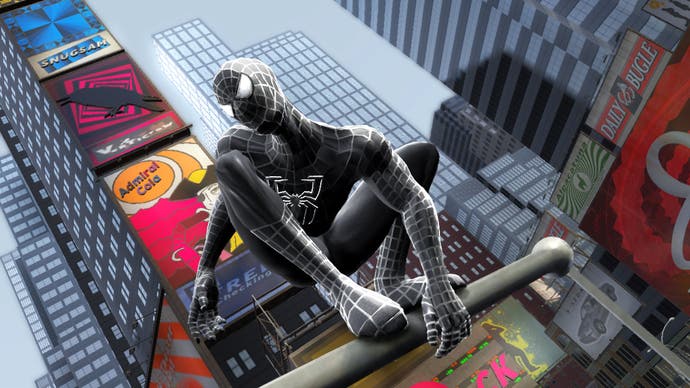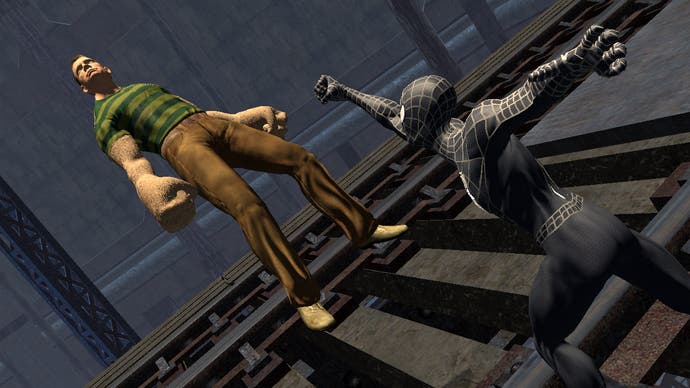Spider-Man 3: The Game
Not a magic number.
Every now and then a game comes along that shatters the long-held notion that movie-based titles are generally a bit of a cash-in waste of time. Sadly, Spider-Man 3 is not that game.
But calling Treyarch's latest stab at at Spidey movie game "a cash-in" or a "waste of time" is a pretty harsh way to kick off a review. It's neither, actually, but nor is it a game that fulfils the oceanic potential of the brand. Just like 2004's Spider-Man 2, it's an admirable game for a decent chunk of it, but one that's beset by the kind of horrible camera issues and rage-inducing difficulty spikes that leave the average gamer utterly exasperated.
One thing the game does boast this time around is an awful lot more content than the last effort. Spanning 42 missions, the more expansive campaign encompasses 10 storylines (including the movie's plot, which we don't know about, not having seen it yet of course), and gone are the stupidly irrelevant pizza-delivery missions and balloon-collecting. As a superhero game, it very much plays things by the book, but by and large it follows the same fast-paced New York web-slinging premise that it did last time.
Forever lost

That's to say that missions appear on the 3D city map, you choose one, web-sling your Lycra-clad behind over to it, find the little spinning icon and get set for some button-mashing, perp-bashing action. Having just played God of War 2 extensively, it shares more than a little common ground with Sony's epic hackandslash. Most obviously, Treyarch has laced key moments of the game with the now obligatory interactive cut-scenes (also know as 'quicktime events', seen in everything from Shenmue to Resident Evil 4) where you must quickly match the HUGE BUTTON PROMPTS as they appear on the screen. Sometimes they're in there to spice up a few spectacular cut-scenes, while on other occasions it's a means of providing a fittingly stunning climax to a boss encounter. You know the drill by now.
You could also argue that the flailing, button-mashing combat is pitched at a similar audience too, where repeatedly hammering either X or Y yields instant reward and sends our friendly neighbourhood crime-fighting dude into a pirouetting frenzy of balletic violence. In other words, it looks amazing, but you never have to work too hard to pull off the spectacular. For a bit of extra combat depth you can mix in some web attacks with B, or jump first with A and hammer out some cartoon violence as you see fit - but at no stage does Treyarch give the impression it's going for anyone but the mass market. Which is kind of the point of a game like this, after all.
Elsewhere, you can usefully slow down time for a brief period by holding down LB, or throw in a super-powerful enemy-clearing attack (once your meter's charged up) by pressing RB and X, Y or B. But the real fun isn't so much in how the combat feels (it's pretty basic, to be frank) but how it translates the action onto the screen. Even more so than before, Treyarch has created a seemingly unending procession of jaw-dropping comedy combos that give Spidey the ability to humiliate his foes as much as possible. Such examples include pinballing Spider-Man between foes in the blink of an eye, stopping only to whack them in the chops, or kicking an opponent repeatedly in the face in mid-air as if running up an imaginary flight of stairs. Later you even get to play as Spidey's dark alter-ego, but apart from his powerful rage mode (activated with RB) he feels identical to play.
Don't give up the fight

The way the controls have been set up leave no doubt that Treyarch wants even modestly skilled players to pull off outrageous moves as often as possible. For example, pummelling X and Y as quickly as possible (i.e. Track & Field fast) sends a similar blizzard of punches to anyone in range, while others send you windmilling around with little more effort required than pressing X very quickly five times in a row. There's little room for subtlety, put it that way, but that's part of its charm.
That's not to say the game's easy. Admittedly, about half the missions won't trouble even modestly skilled players so long as your RSI-ravaged wrists can handle a bit of button-pummelling for extended periods, but there are some absolutely brutal challenges to overcome before you'll clear the game. There's nothing quite as maddeningly ridiculous as some of the missions that cropped up in Spider-Man 2, but nevertheless, you'd better prepare a smattering of cushions to punch when things (repeatedly) go wrong. Something that takes a bit of getting used to is the counter system. For instance, a yellow icon appears at the top of an enemy's head when they're about to strike, giving you the opportunity to hit LB to 'auto dodge', with an X prompt allowing you to whack them where it hurts in response.
For a fair way into the game, you don't really have to worry too much about countering at all, and then you'll hit a horrible, inexplicable brick wall where you'll go from being the all-powerful superhero to the crumpled chump on the floor with a trickle of bloody drool dribbling out of his beaten chops. And then some of the combat 'depth' starts to play a part, where you'll realise that you can't just wade into certain enemies, and that taking extra care and forming a proper strategy is important. Even so, for the most part, it's still the absolute king of button-mashing games. Just watch someone play the game, and focus on their right hand. It's bizarre.








